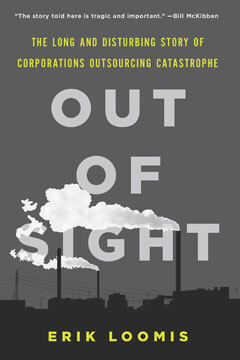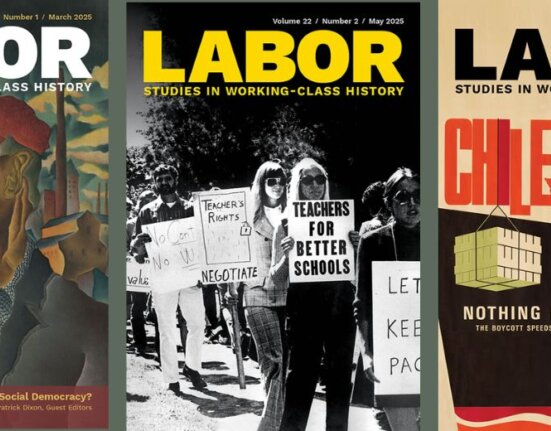The waning days of April have a little recognized convergence, inviting us to think about connections between workers issues and environmental concerns. Earth Day (April 22), now over 40 years old, was initiated to put a stop to the forces of corporate devastation of the earth. Workers Memorial Day (April 28) was initiated to remind people of safety and death toll for workers on the job. The International Labor Organization estimates that more than two million people die of workplace-based accidents or illnesses each year. I am not aware of an estimate for the worldwide death toll from environmental destruction, but capitalist organization of resources seems increasingly a death sentence for the earth.
In addition to these yearly and global commemorations, we have recent devastating events that make late April noteworthy. Lack of workers power contributed to the April 20, 2010 Deepwater Horizon catastophe. The April 24, 2013 Savar building collapse that led to the deaths of thousands of clothing workers in Bangladesh highlights the way that the quest for cheap labor is connected to environmental devastation.

A new book by historian Erik Loomis Out of Sight: the Long and Disturbing Story of Corporations Outsourcing Catastrophe might become a primer on these convergences. His book appears to have been initiated by reflecting on the 2013 Bangladesh disaster and how it both frighteningly similar and dissimilar from the Triangle Shirtwaist Fire of 1911. Comparison between these events is discussed in a powerful video by Charles Kernigan of the Institute for Global Labour and Human Rights. Check it out if you’ve not seen it.
Loomis begins by showing how the shock over the Triangle Fire led to reforms that eventually were incorporated into the New Deal. But that was then. Now, he argues, when corporations have such easy access to outsourcing and mobility as a strategy, we feel more distant from these consequences. Without a major campaign for awareness, no similar regulations will appear. Unlike Triangle where the bodies of girls were heard and seen thudding to the earth, he suggests that the devastation in Bangladesh seems coolly distant from the U.S. even though the market for the goods made by these workers is mostly here.
Loomis intends to use his history to bring these into sight and mind. Seeing labor and environment as connected instead of separate issues, he argues, might produce a movement that moves policy in pragmatic directions to control corporate power. “Distance matters,” he urges, and “corporate mobility . . . has outsourced industrial risk to the world’s poor, separating the costs of industrial production from consumers and undermining labor rights and environmental protections in the United States.” Loomis suggests this is not only a matter of global outsourcing at turbo speed, but something that also happens within state borders (such as when meat production is located in remote areas, obscuring both worker injuries and poverty as well as countryside pollution). He argues this has created a sense of powerlessness among workers that drives them in a race to the bottom. That race to the bottom is simultaneously destroying the environment and empowering capitalists at the expense of both.
Loomis wants to show that “corporate exploitation of labor and the planet are intertwined parts” of capitalism. And on that score his book succeeds. It is a concise accessible book to introduce the subject. Chapters on workplace catastrophes and capital mobility, outsourcing pollution, food chains and climate issues try to show that the more corporate power is enhanced though political power, the greater the toll on both worker and environment.
Loomis explains the lack of coalition between environmentalists and labor despite these convergences as a factor of “jobs vs. environment.” He also rightly argues that there have been moments when it seemed possible for the concerns of workers and environmentalists to converge. But he presents the history of unions as more friendly to environmental concerns than the record shows, and doesn’t consider how much the structures of unions are impediments to building alliances and coalitions. He steps softly so as not to offend.

The problem is that alliances and coalitions are difficult to generate when allegiance to industry and the specific jobs it produces is a rule of the game and so well-practiced. Today unions such as the Laborers’ support corporate fracking deals in exchange for a scant number of jobs. It’s usually been only in the context of a strike, boycott or particular campaign that unions welcome coalition with environmental groups, a kind of temporary movement coalition. As Trish Kahle summarized it in a great piece in Jacobin last summer, corporations have consolidated energy power triangles, but unions in these industries have not reconsidered their overall relationship to each other and the industry. These unions are pretty critical in the energy power nexus, and it’s not because of capital mobility that they failed to act. We can see an insurgent spirit is a small areas, applaud initiatives such as The Labor Network for Sustainability, hope that these projects will produce better results than they have in the past. But the fact remains that even as the corporate form gets more wily and destructive, old union forms and even mergers impede visionary coalition-building.
When unions have made ties to coalitions beyond their industries, it was from understanding and thinking critically about capitalism and acting with broad visions for the future. For example, it was the radical UE District 8 in the 1930s that worked for an environmentally responsible Missouri Valley Authority; the radical Miners For Democracy that moved the United Mine Workers of America toward connecting with coalitions beyond the worksite. Recently, a rank-and-file movement Railroad Workers United is attempting to unite workers to fight for the environment and jobs as a coalition of various unions.
This begs the question, was it mainly distance, or the core anti-radicalism and business union structures of unions inherited from the past that have been the impediments to these kinds of coalitions? The notions that unions capitulated to a corporate agenda because of outsourcing and global capital strategy is at best only part of the story for the kind of inaction and thwarting of social movements that has impeded union effectiveness. And these didn’t happen only since the 1970s. Many of the kinds of problems we face in the labor movement are the results of employer offensives that span the 20th century and have little to do with outsourcing in a global economy. Distance and outsourcing as the main explanation of labor’s lack of power doesn’t adequately explain the problem we face.
What are we to do? Here, Loomis ends his primer with policy prescriptions and concertedly pragmatic advice for activism based on his understanding of history, a “usable past.” He hopes for a new progressive movement that sticks to pragmatic ways of controlling corporate mobility and creating global regulations. He offer projects that could make “think globally, act locally” meaningful to those just getting interested in the movement. Arguing that the accomplishments of social movements are measured by legislation and policy changes that lived on after they were gone, he offers some valuable examples of what he suggests could produce significant policy outcomes. These are certainly worth a look, while others seem “utopian,” such as the advice to take over the Democratic Party (given labor leadership’s embedded status no matter what it gets handed.)
Without debate and argument about how we get from here to there, social movements lose their way. It might be remembered that Dr. King did not aim for the Civil Rights Act and Voting Rights Act in respect to the goal of freedom that was the core of the movement, that after these passed he was ever more convinced that what was missing was a way to address directly the capitalist system, the belly of the beast. Might we take a cue from that to understand what moves a movement? The labor movement is beaten down now because along the way it eliminated its left and most of its debate, became more firmly embedded in the premises of capitalism. It is still embedded in those premises despite the record hits it has taken in the last decades. If unions ever emerge as vibrant parts of a green-worker alliance, it will involve building a left in unions willing to rethink the premises of the workplace built on capitalist premises, the kind of left that emerged in the first gilded age, and the kind of insurgency that emerged then too. Loomis’ snapshot view gives us some fuel for that kind of thinking and debating.






